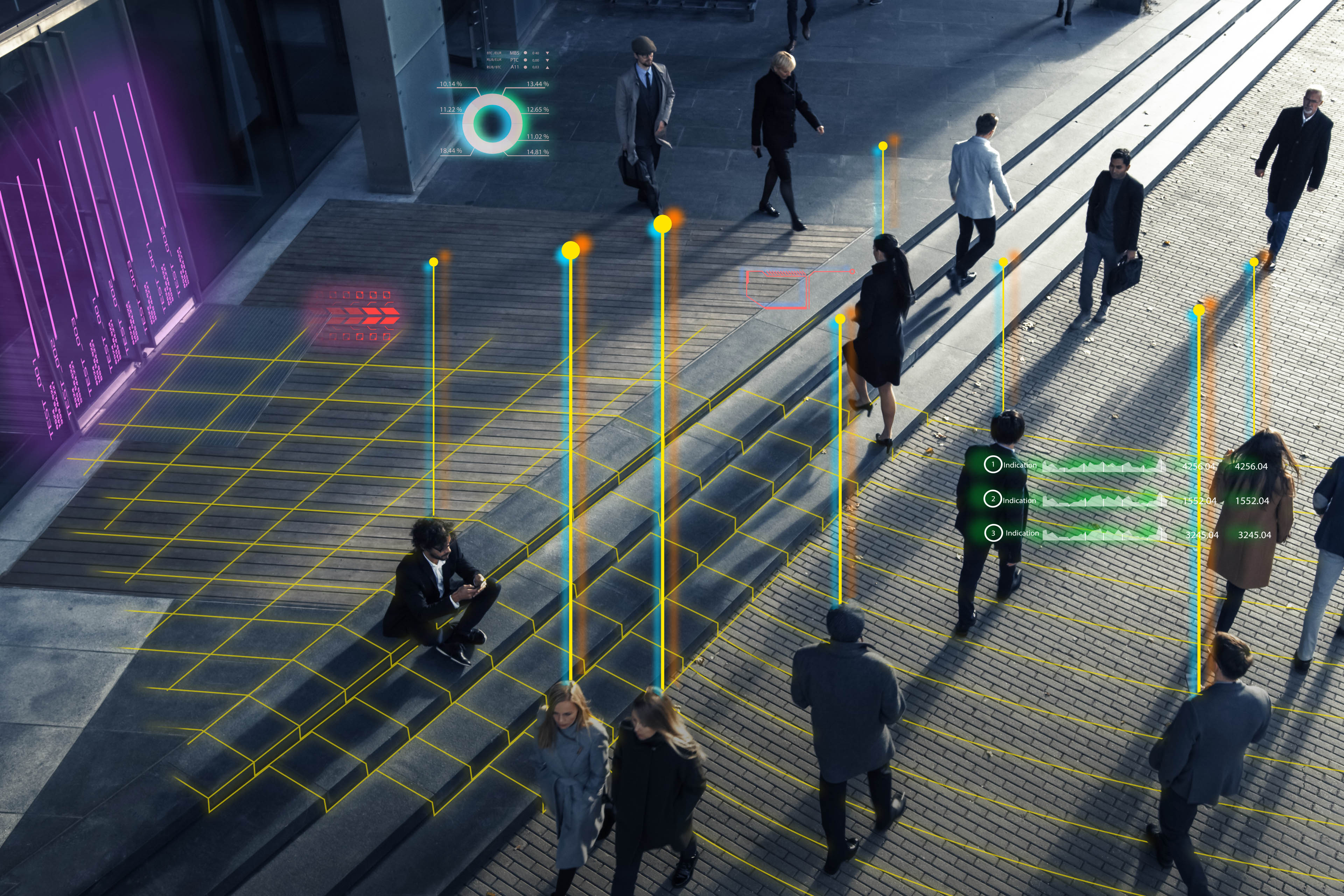EY refers to the global organization, and may refer to one or more, of the member firms of Ernst & Young Global Limited, each of which is a separate legal entity. Ernst & Young Global Limited, a UK company limited by guarantee, does not provide services to clients.

Want to read the full report?
People want more information on safe, responsible and ethical AI use. We identify how organizations can address AI anxiety to unlock value.
To discover what’s keeping people and business leaders up at night, we commissioned an online survey of 1000 Americans who work an office/desk job and are at least somewhat familiar with artificial intelligence across generations and industries. Here’s what we found.

Chapter 1
AI is now in the hands of your workforce
The rise of GenAI has given more people direct exposure to AI, with largely positive sentiment.
An overwhelming 90% say their organization uses at least one AI technology, with GenAI topping the list.
The rise of GenAI has given more people direct exposure to AI, with largely positive sentiment. An overwhelming 90% say their organization uses at least one AI technology, with GenAI topping the list. Most believe AI will make them more efficient (82%), more productive (81%) and able to focus on higher value work (81%).
Figure 1: AI technologies people use at work
Most (76%) say AI has already had a positive impact on their personal experience at work but concerns remain. These center on AI adoption making certain jobs obsolete (75%), negative impacts on pay/salary (72%) and career growth. Career concerns include losing out on promotions for not knowing how to use AI technology (67%) and falling behind if they don’t use AI at work (66%).

Chapter 2
Curiosity in AI does not equal confidence
While most employees say they trust AI technologies (77%), almost as many indicate concerns about AI (71%).
While most employees say they trust AI technologies (77%), almost as many indicate concerns about AI (71%). Greater exposure to AI has increased, rather than lessened, anxieties, with about half (48%) more concerned about AI than they were a year ago.
Top issues are the quality of AI outputs and the speed at which AI is being adopted. In a world of rising misinformation, deepfakes and malicious hackers, people are worried about the unintended consequences of AI. They feel it’s all happening too quickly.
Figure 2: What is triggering AI anxiety?
Employees are also anxious about whether they, personally, are using AI responsibly (65%). Their concerns span cybersecurity (75%), legal implications (e.g. plagiarism, intellectual property rights) (77%), ethical and moral considerations (e.g. potential bias and discrimination) (71%). They want more guidance and regulation to gain a deeper understanding of AI: what constitutes responsible, legal and ethical use and what does not.
While 81% of employees say AI technology organizations need to self-regulate more, nearly as many (78%) say the government needs to play a bigger role in regulating AI technology. (This survey was completed on 16 October 2023, two weeks before the announcement of President Biden’s Executive Order on safe, secure and trustworthy artificial intelligence).
Want to read the full report?

Chapter 3
Significant generational differences could impede adoption of AI
Our research revealed some interesting generational divides between who is using AI, how much they trust it and what value they think it will bring.
Our research revealed some interesting generational divides between who is using AI, how much they trust it and what value they think it will bring.
Figure 3: Generational differences
Millennials (born 1981-1996) and Gen X (born 1965-1980) emerge as more open to AI: they trust and use it at work and see value in adopting it at work.
In contrast, Gen Z (born 1997-2005) and baby boomers (born 1940-1964) are less likely to trust it. To add context to these results, we spoke with EY Americas Cultural Insights and Customer Strategy Leader, Marcie Merriman. “While this may come as a surprise to many, for the youngest and oldest generations in the workplace, trust in AI isn’t just about safety and security: it’s whether the technology works.”
Merriman points out that Gen Z has highest expectations of technology. AI has been embedded into their everyday lives since birth, from facial recognition on phones to GPS navigating them through cities. If one app or platform doesn’t work easily and seamlessly, they quickly move on to others. Baby boomers, on the other hand, started their careers with less need to be hands-on with technology. As technology![]() gained ground in the workplace of the 80s and 90s, Baby boomers often depended on lower-level employees (typically Gen X), to master spreadsheets and build presentations.
gained ground in the workplace of the 80s and 90s, Baby boomers often depended on lower-level employees (typically Gen X), to master spreadsheets and build presentations.
In contrast to boomers, Gen X and Millennials have had to adapt to new technologies continuously and on the fly. Gen X has had to learn and adapt to more business-altering technologies than any other generation.
As a consequence, Gen X understands the risks of not keeping up and have a greater tolerance for dealing with unreliable technology. They’re more likely to work through technical challenges and appreciate the value of MVPs (minimum viable products).
What should leaders take away from these gaps? Organizations should avoid rushing AI deployments and expecting to improve it along the way if engagement by Gen Z or Baby boomers is critical. What the middle generations embrace may not pass muster for those at either end of the generational spectrum. To win over Gen Z—and this encompasses the future workforce and consumers—organizations must be purposeful and start with robust, responsible AI that performs as promised.
They won’t get a second chance.

Chapter 4
Organizations can’t afford to wait
With AI already in the hands of their workforce, organizations need a clear plan for AI in action today.
With AI already in the hands of their workforce, organizations need a clear plan for AI in action today. The good news is that there are clear steps businesses can take to reduce anxiety and help employees.
First and foremost is to train and educate the workforce. Our survey data shows an overwhelming desire for more: more training, more communication, more transparency. People want a deeper understanding of AI leading practices and how the organization is using data. To replace uncertainty with confidence, they want to know how to use AI securely, responsibly and ethically.
They also want to know more about what the organization itself is doing: more than two-thirds would feel more positive about their employers if they were transparent about AI and data use, as well as getting AI applications reviewed by a third party.
Figure 4: What will make people more comfortable about using AI at work?
Despite this thirst for more knowledge and training, employees are worried that opportunities will not be available to them. When thinking of AI adoption in the workplace, 73% are concerned that there won’t be sufficient AI training and upskilling opportunities, with 63% of employees expressing anxiety about not having access to AI training and upskilling. For organizations investing in training or making training available to employees, it is clear there is no such thing as too much communication.

Chapter 5
Top of mind, top of agendas
With the wealth of opportunities that AI brings, it also carries a new set of risks—risks that are top of mind for employees.
With the wealth of opportunities that AI brings, it also carries a new set of risks—risks that are top of mind for employees. While the technology is prevalent, increased exposure to AI is leading to increased anxiety for many. It’s important for leaders to meet employees where they are in their AI journey, and add employee engagement to their AI agendas. Armed with a deeper understanding of what is driving anxiety around AI, organizations can then take the appropriate steps to work through workforce concerns and equip their people for today’s, and tomorrow’s, challenges.
Figure 5: What would make people view an organization that uses AI positively?
The team
Our latest thinking
Six pillars for AI success: how the C-suite can drive results
Competitive advantage rests on these capabilities and functions. But overlooking just one creates an unstable foundation. Learn how to evolve quickly.
Why enabling AI’s full value requires top-down thinking
To realize AI’s full potential, companies should develop AI capability in a way that is integrated and top down. Read more.
How to create an AI strategy during peak AI
From the doctor’s waiting room to the boardroom, AI is everywhere. Learn more.
How blockchain helped a gaming platform become a game changer
Microsoft Xbox and EY implemented a transparent blockchain network so game publishers, creators and asset owners can focus on the future.









